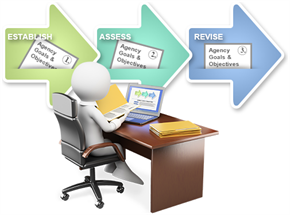Evaluation
Overview
Evaluation is critical to the Human Capital Framework as agencies need to measure the success of their strategic plans and human capital management. Evaluation is a process and a system that operates at all levels to help the organization reach its goals.
Evaluation Definition:
A system that contributes to agency performance by monitoring and evaluating outcomes of its human capital management strategies, policies, programs, and activities.
Standard:
The standards for the evaluation system require an agency to:
- Ensure compliance with merit system principles; and
- Identify, implement, and monitor process improvements.
Outcomes:
- Continuous and innovative improvement:
- Executives, managers, and employees discover innovative ways to enhance program performance and mission outcomes.
- Holistically informed decisions:
- Executives, managers, and employees utilize information from different sources to make program, policy, and mission-related decisions to improve outcomes.
- Integrity
- The agency leadership makes mission-related decisions on reliable data, serving the interests of the American public.
- Excellence:
- The agency leadership and employees establish high success standards through strategic and operational planning activities and collaborate to achieve program performance expectations and mission outcomes.
Strategic View — Senior Leadership
 The passage of the Government Performance and Results Act Modernization Act of 2010 (GPRAMA) strengthened the importance of using performance information to achieve both Federal Government Priority Goals and Agency-Specific Priority Goals.
The passage of the Government Performance and Results Act Modernization Act of 2010 (GPRAMA) strengthened the importance of using performance information to achieve both Federal Government Priority Goals and Agency-Specific Priority Goals.
Agencies prepare for their quarterly, data-driven performance reviews by collecting and analyzing program-related outcomes that reflect the impact of key mission related goals and objectives as required per the GPRAMA. The Chief Human Capital Officer (CHCO), Chief Information Officer (CIO), Chief Financial Officer (CFO), Chief Administrative Officer (CAO), and Performance Improvement Officer (PIO) collaborate with the agency's Chief Operating Officer (COO) to review performance trends, identify reasons for variances, and assess if program activities, regulations, policies, and other activities are contributing to the agency priority goals.
CHCOs play an integral role by analyzing the efficiency, effectiveness, and compliance of their agency's human capital program to demonstrate the human capital program's impact on the agency's mission, strategic and priority goals and policies. In order to do this, CHCOs lead HRstat quarterly data driven reviews.
The Evaluation System is a framework for monitoring, analyzing, reporting, and enhancing agency performance across human capital management policies, programs and activities. By establishing this framework, agencies will ensure that their human capital programs support mission accomplishment while complying with established Merit System Principles.
However beautiful the strategy, you should occasionally check the results.
Source: Winston Churchill
What Does This Mean To You As A Senior Leader?
Senior leaders have a responsibility to establish, assess and revise agency goals and objectives.
Actions / Decisions For Senior Leaders
Plan
- Clearly define the organizational mission. Clearly link the work of the organizational unit to the overall organization, and cascade performance objectives and expectations down to the lowest level via a strategic plan and discussions with your CHCO and PIO. Leave room for conversations between managers and employees and for adjustments throughout the year.
- The strategic plan should include the objectives, results/outcomes, and measures that senior leaders use to make fact-based decisions to support the mission.
- Coordinate with HR:
- To recruit and maintain a ready workforce (right people in right jobs with the right skills/competencies at the right time) to support the mission and strategic plan, and ensure compliance with Human Resources regulations and policies.
- Ensure the agency has succession plans, training and development plans, and a workforce plan.
- Ensure the Agency HR Policies and Labor Management Agreements are current and accurate.
Implement
- Senior leaders should communicate the mission of the overall organization; the missions of the organizational units; performance objectives and expectations; results/outcomes; and measures to management and employees.
- Monitor compliance with HR regulations and policies in your performance management plans.
- Hold meetings focused on objectives, measures, results/outcomes.
- Maintain a focus on the linkage between results/outcomes and the agency's mission and strategy. Use results to make decisions.
- Meet with the PIO so that you are aware of organizational performance.
- Meet with the CHCO to help maintain a ready workforce and monitor compliance with HR regulations and policies.
- Make fact-based decisions using results/outcomes data, succession plans, training and development plans, and workforce plans.
Evaluate
Evaluate the performance of the overall organization and your organizational unit. Ask:
- Were the expected outcomes achieved?
- Did the agency measure the right things?
- Were there missed opportunities?
- Were human capital strategic objectives considered and addressed?
- What were the impacts of compliance/non-compliance with HR regulations/policies (e.g., amount of management time spent resolving HR non-compliance issues such as grievances, pre-selection, inaccurate position descriptions)?
- Did leaders and managers comply with required/recommended actions?
- Did the organization have a ready workforce?
Operational View — HR Practitioners And Program Supervisors
 Operations are the points of overseeing, designing, and controlling a program or a process. Operation managers and employees ensure that business operations are efficient and effective in meeting customer requirements. They analyze and evaluate the inputs, processes and outputs of a system.
Operations are the points of overseeing, designing, and controlling a program or a process. Operation managers and employees ensure that business operations are efficient and effective in meeting customer requirements. They analyze and evaluate the inputs, processes and outputs of a system.
What Does This Mean To You As A Program/Process Owner Or HR Professional?
Everything that can be counted does not necessarily count; everything that counts cannot necessarily be counted.
Source: Albert Einstein
The Program/Process Owner's day should begin with a review of evaluation results. You need to know where you are in the process/program and how you are doing, and the answer should determine what you are going to focus on that day.
Actions / Decisions For Program Owner And HR Professionals
Does each organizational unit have the right people with the right skills and competencies to perform the job at the right level today and for the future? Will the current budget allow the organization to address recommended and required actions? Does the organization have a viable succession plan and training/development plan?
What was the impact of non-compliance with HR regulations/policies (e.g., amount of management time spent resolving HR non-compliance issues such as grievances, pre-selection, inaccurate position descriptions)?
Plan
- Ensure that the HR staff responsible for measuring program effectiveness understands the connections between the strategic and operational aspects of human capital management, including the impact policies, procedures, and regulatory compliance have on mission objectives and outcomes.
- Establish a calendar outlining reporting processes, procedures, and timelines. Include information such as the intent of each report, audience (internal versus external), due dates, key data sources, and roles and responsibilities for reviewing, finalizing, and issuing reports.
- Develop an evaluation plan for those with delegated HR authority. Make a long-term plan to evaluate offices every two years at minimum.
Implement
- Train hiring and program managers on their HR roles and responsibilities. Have a conversation about expectations and the support/advisory services available from HR.
- Communicate with executives and program managers to identify and resolve practices that compromise the Federal HR legal, regulatory, and policy framework, including the Merit System Principles and Prohibited Personnel Practices.
- Create and maintain accurate organizational charts to define and manage lines of authority and roles and responsibilities.
- Implement the delegation of authority evaluation plan.
Evaluate
- Create an inventory of program data sources to assess how results are captured, measured, and reported.
- Explore innovative ways to improve data gathering and analysis.
- Deploy innovative processes to measure outcomes against program performance objectives and mission expectations.
- HR and program managers should use outcome measures and business analytics to assess the effectiveness of HC management strategies.
- Analyses should focus on return on investment or results achieved rather than activities performed.
- HR and program managers should report assessment results to inform goal leaders and drive change.
- Management strategies and practices should be adjusted based on data driven decisions.
Employee View
 Senior leaders and program/process owners carry most of the responsibility for creating and implementing formal evaluations. However, employees at all levels can contribute to business analytics and data-driven decision-making. Employees should pay attention to process efficiency and effectiveness and offer suggestions for improvement. Along with participating in formal evaluation efforts, employees also should look for improvement in their contributions to Agency mission and objectives. Track lessons learned from outcomes that met, exceeded, or fell short of expectations.
Senior leaders and program/process owners carry most of the responsibility for creating and implementing formal evaluations. However, employees at all levels can contribute to business analytics and data-driven decision-making. Employees should pay attention to process efficiency and effectiveness and offer suggestions for improvement. Along with participating in formal evaluation efforts, employees also should look for improvement in their contributions to Agency mission and objectives. Track lessons learned from outcomes that met, exceeded, or fell short of expectations.
What Does This Mean To You As An Employee Of Your Organization?
Measures and results provide a common language for all employees. Common language and accurate measures encourage better conversations. Better conversations should lead to better results, and better results contribute to satisfied stakeholders and customers along with increased job satisfaction.
Actions / Decisions For Employees
Approach challenges with a focus on continuous improvement. When you notice a problem or inefficiency, think about potential solutions and discuss this with your supervisor or other stakeholders. Work with them to come up with the best solution, and bring it to the attention of leadership.
Plan
- Read your position description thoroughly. Alert your manager if it does not accurately describe what you do. How does your job fit into the organization's mission? Discuss your performance objectives with your manager. Ensure you and your manager share understanding of your expectations and objectives. These discussions should go beyond what duties you have and should include the outcomes your actions should produce, the importance of these outcomes, when they should be achieved, and how they are measured. Discuss the stakeholders of the larger system and higher-level processes that influence or depend on your individual processes.
- Create an action plan for how you will achieve your outcomes and expectations.
Implement
- Follow the action plan.
- Document progress along with any issues or barriers.
- Resolve problems if possible.
- Bring larger problems to the attention of management.
Evaluate
Ask yourself:
- Did I perform the duties as described in my position description? What was different? Why? Did I bring up discrepancies to my manager?
- Did we measure the correct things at the correct times?
- Are there different or additional measures needed? Are there things that were measured that did not add value to the evaluation process?
- Were problems resolved in a timely manner? If not, what were the barriers?



